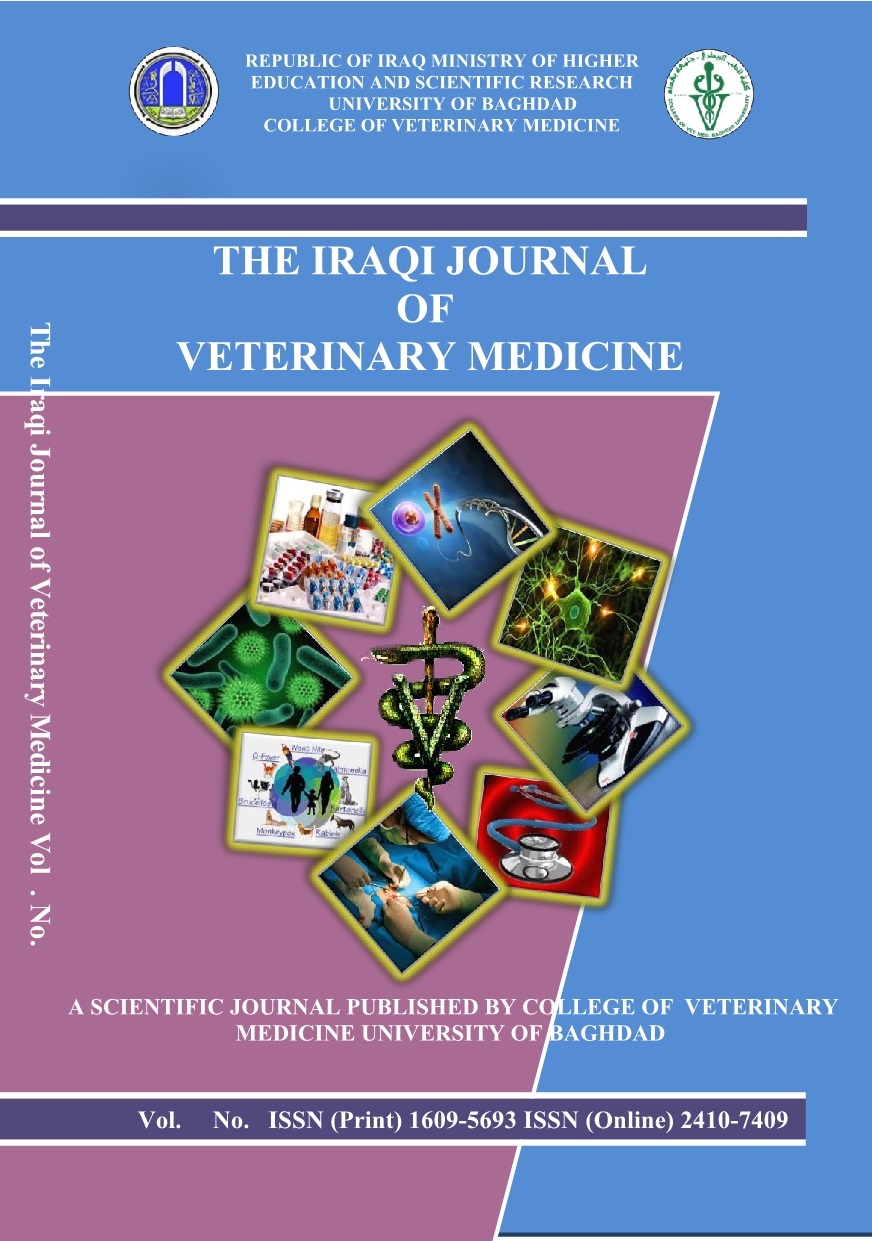Abstract
This study was carried out at the poultry farm of the college of veterinary medicine / Baghdad University during 12/5/2004 – 6/7/2004 to study the effect of substitution of smut wheat instead of intact wheat in poultry ration at the following levels (0%, 25% , 50% and 100%) representing the following groups (T0, T1, T2 and T3), respectively. Physical treatment was obtained for smut wheat by polishing the seed by sand to remove the superficial fungal growth. Each group was sub divided into two sub groups, one was physically treated with sand and the other was not treated to study the hematology traits at 28 and 56 days of the experiment. Characterristics included in this study were PCV, Hb, RBC, WBC, differential leukocyte count and some of serum blood enzymes activity (ALT, AST and AP). The results obtained revealed the following:
Replacing partial of smut wheat at the level of 50% or total 100% caused an imbalance of blood parameters by decreasing PCV, Hb, RBC, WBC and increased blood enzymes activity of ALT, AST and decreased AP activity. Results of differential leukocyte count revealed that heterophils were increased while lymphocytes were decreased significantly (P<0.05) at 28 and 56 days of age. Physical treatment of smut wheat by sand improve the blood parameters by rebalancing these parameter in comparison with these of untreated group .
Replacing partial of smut wheat at the level of 50% or total 100% caused an imbalance of blood parameters by decreasing PCV, Hb, RBC, WBC and increased blood enzymes activity of ALT, AST and decreased AP activity. Results of differential leukocyte count revealed that heterophils were increased while lymphocytes were decreased significantly (P<0.05) at 28 and 56 days of age. Physical treatment of smut wheat by sand improve the blood parameters by rebalancing these parameter in comparison with these of untreated group .
Abstract
أجري البحث في حقل الطيور الداجنة التابع لكلية الطب البيطري/ جامعة بغداد للمدة من 12 / 5 / 2004 ولغاية 6 /7 / 2004 واستهدف تقييم احلال الحنطة المتفحمة محل نسبة الحنطة السليمة في عليقة فروج اللحم حيث أحلت %0 ، %25 ، %50 ، %100 من الحنطة المتفحمة محل نسبة الحنطة السليمة في علف فروج اللحم (المعاملات T0 ، T1 ، T2 ، T3) على التوالي ، وجرت محاولة تقليل الاثار السلبية للتفحم الموجود في الحنطة من خلال معالجتها بطريقة الحك بالرمل ، وعليه فأن كل معاملة رئيسة قسمت الى معاملتين غير معالجة (c) ومعالجة (t) وجرى دراسة بعض مؤشرات الصورة الدموية التي اشتملت على
(Packed Cell Volum) PCV ، (Hemoglobin) Hb ، (Red Blood Cell)RBC ، (White Blood Cell )WBC ، والعدد التفريقي لخلايا الدم البيض وتحديد نشاط خمائر (Alanine aminotransferase) ALT، (Aspartate aminotransferase) AST ، (Alkaline phosphatase) AP وقد بينت النتائج ما يأتي:
أدت عملية الاحلال الجزئي بنسبة 50% أو الكلي للحنطة المتفحمة الى اختلال مؤشرات الصورة الدموية ، وقد ظهر ذلك متمثلاً بانخفاض PCV ، Hb ، RBC ، WBC ، وزيادة نشاط خمائر ALT ، AST وفي الوقت نفسه انخفضت خميرة AP وأشارت نتائج العد التفريقي الى حصول زيادة في أعداد الخلايا المتغايرة ، وانخفاض الخلايا اللمفية عند عمر 28 ، 56 يوماً. وقد أدت عملية معالجة الحنطة المتفحمة بالرمل الى اعادة التوازن الى مكونات الدم من خلال اعادة التوازن لمؤشرات الدم المدروسة مقارنة بنفس معاملة الاحلال غير المعالجة بالرمل.
(Packed Cell Volum) PCV ، (Hemoglobin) Hb ، (Red Blood Cell)RBC ، (White Blood Cell )WBC ، والعدد التفريقي لخلايا الدم البيض وتحديد نشاط خمائر (Alanine aminotransferase) ALT، (Aspartate aminotransferase) AST ، (Alkaline phosphatase) AP وقد بينت النتائج ما يأتي:
أدت عملية الاحلال الجزئي بنسبة 50% أو الكلي للحنطة المتفحمة الى اختلال مؤشرات الصورة الدموية ، وقد ظهر ذلك متمثلاً بانخفاض PCV ، Hb ، RBC ، WBC ، وزيادة نشاط خمائر ALT ، AST وفي الوقت نفسه انخفضت خميرة AP وأشارت نتائج العد التفريقي الى حصول زيادة في أعداد الخلايا المتغايرة ، وانخفاض الخلايا اللمفية عند عمر 28 ، 56 يوماً. وقد أدت عملية معالجة الحنطة المتفحمة بالرمل الى اعادة التوازن الى مكونات الدم من خلال اعادة التوازن لمؤشرات الدم المدروسة مقارنة بنفس معاملة الاحلال غير المعالجة بالرمل.
